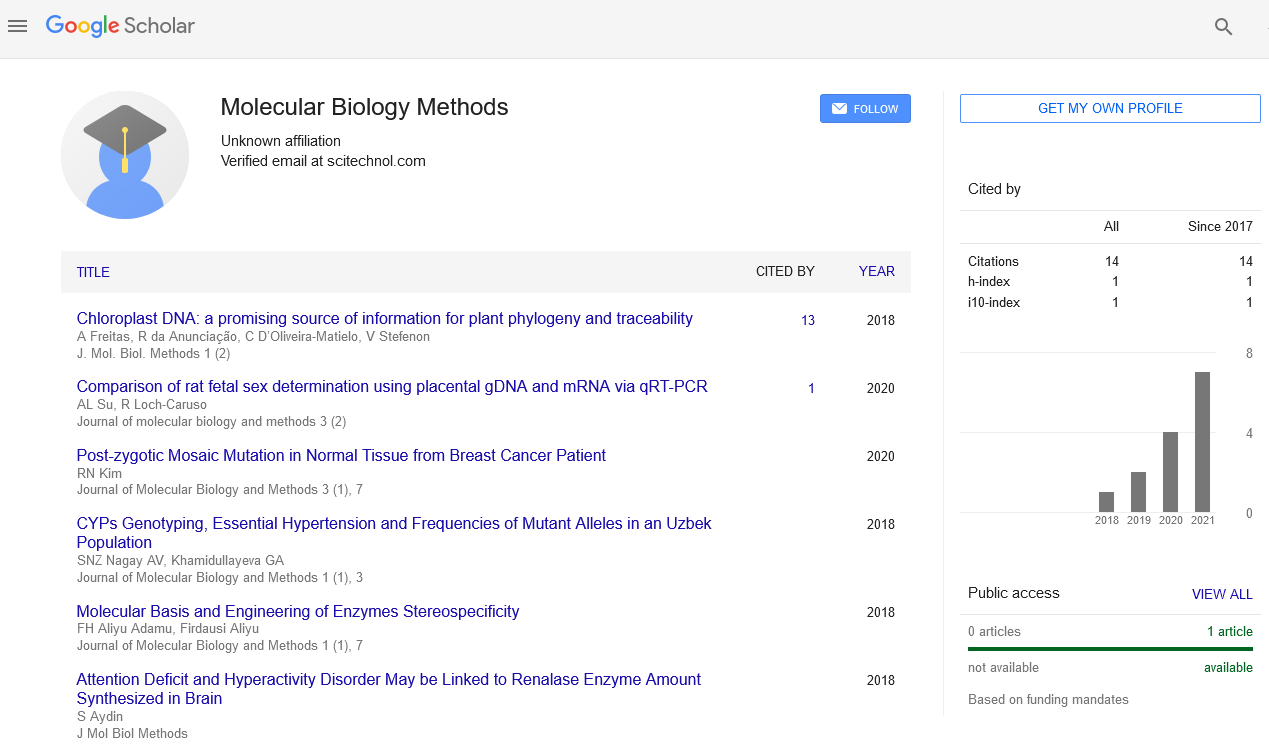Perspective, J Mol Biol Methods Vol: 7 Issue: 1
Decoding Life: A Comprehensive Guide to DNA Sequencing
Roberto Stillman*
1Department of Biology, Colorado State University, Colorado, United States of America
*Corresponding Author: Roberto Stillman,
Department of Biology, Colorado State
University, Colorado, United States of America
E-mail: stillmanroberto@ac.edu
Received date: 26 February, 2024, Manuscript No. JMBM-24-136935;
Editor assigned date: 29 February, 2024, PreQC No. JMBM-24-136935 (PQ);
Reviewed date: 14 March, 2024, QC No. JMBM-24-136935;
Revised date: 21 March, 2024, Manuscript No. JMBM-24-136935 (R);
Published date: 28 March, 2024, DOI: 10.4172/JMBM.1000154
Citation: Stillman R (2024) Decoding Life: A Comprehensive Guide to DNA Sequencing. J Mol Biol Methods 7:1.
Description
DNA sequencing stands as one of the most revolutionary advancements in modern science, unlocking the mysteries of life encoded within the double helix structure of DNA.
Methodologies of DNA sequencing
Here are some of the key methodologies of DNA sequencing:
Sanger sequencing: Sanger sequencing, also known as the chaintermination method, remains a cornerstone in DNA sequencing. It involves DNA synthesis via DNA polymerase, using a template strand, primers, and fluorescently labeled dideoxynucleotides. As the polymerase incorporates these nucleotides, DNA fragments of varying lengths are generated. Through capillary electrophoresis, these fragments are separated based on size, allowing for the determination of the DNA sequence.
Next-Generation Sequencing (NGS): The advent of NGS technologies revolutionized DNA sequencing by enabling highthroughput, massively parallel sequencing of DNA fragments. NGS platforms, such as utilize diverse sequencing chemistries and detection methods. Common steps include DNA fragmentation, library preparation, sequencing-by-synthesis, and data analysis. NGS facilitates diverse applications, including whole-genome sequencing, exome sequencing, transcriptome analysis, and metagenomics.
Third-generation sequencing: Third-generation sequencing technologies, exemplified by Single-Molecule Real-Time (SMRT) sequencing developed by pacific biosciences and nanopore sequencing by distinct advantages over traditional methods. These approaches directly sequence single DNA molecules in real-time, eliminating the need for DNA amplification and reducing errors associated with PCR.
Nanopore sequencing, in particular, utilizes protein nanopores embedded in a membrane to detect nucleotide sequences as DNA strands pass through, enabling rapid and portable sequencing applications.
Applications of DNA sequencing
The process of determining the precise order of nucleotides within a DNA molecule, has revolutionized various fields of science and medicine. Here are some applications:
Genomic research: DNA sequencing has revolutionized genomic research, facilitating the comprehensive analysis of genetic variation, gene expression, and genome organization. Whole-Genome Sequencing (WGS) and whole-Exome Sequencing (WES) have unraveled the genetic basis of diverse traits, diseases, and evolutionary processes. Population-scale sequencing initiatives, such as the Human Genome Project and the 1000 Genomes Project, have provided invaluable genomic resources for understanding human diversity and disease susceptibility.
Clinical diagnostics: In clinical settings, DNA sequencing plays a pivotal role in diagnosing genetic disorders, guiding personalized medicine, and informing treatment decisions. Targeted sequencing panels, focusing on disease-associated genes or genomic regions, enable efficient detection of pathogenic variants linked to inherited diseases, cancer, and pharmacogenetic traits. Furthermore, liquid biopsy approaches utilize circulating tumor DNA (ctDNA) for noninvasive cancer detection, monitoring treatment response, and detecting minimal residual disease.
Evolutionary biology: DNA sequencing has illuminated the evolutionary relationships among species, populations, and individuals, shedding light on evolutionary processes, speciation events, and adaptation mechanisms. Phylogenetic analyses based on DNA sequences have reconstructed the tree of life, elucidated the origins of biodiversity, and traced the migration patterns of organisms across continents. Ancient DNA sequencing has unlocked the genetic legacy of extinct species, unraveling their evolutionary history and ecological roles.
DNA sequencing stands as a testament to human ingenuity and curiosity, empowering us to decipher the blueprint of life with unprecedented precision and scale. From unraveling the mysteries of evolution to revolutionizing clinical diagnostics, DNA sequencing continues to reshape our understanding of biology and medicine. As we venture into the era of personalized genomics and systems biology, the journey of DNA sequencing unfolds new vistas of discovery and innovation, promising to illuminate the path towards a healthier, more resilient future.
 Spanish
Spanish  Chinese
Chinese  Russian
Russian  German
German  French
French  Japanese
Japanese  Portuguese
Portuguese  Hindi
Hindi 